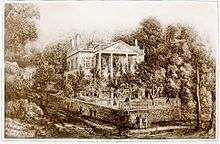Olivia Egleston
Olivia Egleston Phelps (March 30, 1784 – April 24, 1859) was an American philanthropist who was the wife of businessman Anson Greene Phelps, co-founder of the Phelps Dodge Company.
Olivia Egleston Phelps | |
|---|---|
| Born | Olivia Egleston March 30, 1784 Middletown, Connecticut, U.S. |
| Died | April 24, 1859 (aged 75) |
| Spouse(s) | Anson Greene Phelps |
| Children | 8 |
| Parent(s) | Elihu Egleston Elizabeth Olcott Egleston |
| Relatives | Anson Phelps Stokes (grandson) William E. D. Stokes (grandson) |
Early life
Olivia was born in Middletown, Connecticut on March 30, 1784. She was the daughter of Elihu Egleston (d. 1803) and Elizabeth (née Olcott) Egleston (d. 1828).[1]
Her maternal grandfather was George Olcott Jr. and her older siblings were Elizabeth Egleston, George Egleston, and Elihu Egleston Jr..[1]
Personal life
_Stokes_family_tree.jpg)
Olivia was married to Anson Greene Phelps (1781–1853), a businessman who was the co-founder of the Phelps Dodge Company. The other partners in the business were their son, Anson, and sons-in-law, Daniel James, William Dodge and James Stokes. Together, Olivia and Anson were the parents of the following children:
- Elizabeth Woodbridge Phelps (1807–1847), who married Daniel James in New York City on March 24, 1829.
- Melissa Phelps (1809–1903), who married William Earle Dodge on June 24, 1828.
- Caroline Olivia Phelps (1811–1812), who died young.
- Caroline Phelps (1812–1881), who married James Boulter Stokes in New York City on April 12, 1837.
- Harriet Phelps (1815–1892), who married Charles Floyer Pond (1809–1867), President of the New Haven, Hartford and Springfield Railroad, on May 24, 1836.
- Anson Greene Phelps Jr. (1818–1858), who married Jane Gibson (1818–1908) in 1845.[lower-alpha 1]
- Olivia Egleston Phelps (1821–1894), who married Benjamin Bakewell Atterbury (1815–1900) on April 21, 1847.[lower-alpha 2]
- Lydia Ann Phelps (1823–1831), who died young.[2]
After the death of Olivia's husband on November 30, 1853, the partners in the firm bought his holdings from her for $700,000 (equivalent to $21,512,400 today).[3] Olivia, who was also the sole executrix of his will, continued to live in their home on the East River with her daughter, Olivia, and husband, Benjamin Bakewell Atterbury, plus their children.[4]
Olivia's final years were difficult. Initially there were three executors of her husband's will, Olivia, her son Anson and son-in-law William Earl Dodge. Anson and Dodge withdrew because of conflicts of interest in respect to their business connections to Phelps Dodge & Co. The will was contested on many points by the beneficiaries, including their children and grandchildren, and Olivia sought clarification via the courts. The complexity of the arguments resulted in up to 12 lawyers in court at any one time.[5] In 1858 tragedy struck when Olivia's only son, Anson Greene Phelps Jr., died of smallpox and within a year, Olivia herself died in New York on April 24, 1859. It was 1861 before the final verdict on Anson Greene Phelps's will was given by the Court of Appeal.[6][7]
Philanthropy

Olivia shared in her husband's religious devotion and charitable works, supporting many causes including the Society for the Relief of Half Orphans and for 25 years she was a member of the board for the Association for the Relief of Aged and Respectable Indigent Woman.[8] In her home, she entertained missionaries and evangelists including Charles Grandison Finney who, with his family, stayed with the Phelps during his preaching at the Presbyterian church in Vandewater Street, New York (1829-1830).[9]
Residence
This house had originally been built by Henry A. Coster, the Dutch merchant, in about 1810. He planted the grounds with rare fruit, plants, trees, and it was said to have been one of the finest private gardens in America. It was bought by Phelps in 1835 who then acquired adjoining properties, so that the land eventually extended from Third Avenue to the East River, and from Twenty-ninth to half-way between Thirty-third and Thirty-fourth streets. The house was of old Colonial architecture, with out-buildings, hothouses, a large conservatory of rare fruits and flowers, gardener's lodge, stabling, summer house and boat house. From the east portico there were views over the lawn, garden, pasture, and river. A cedar of Lebanon that shaded the ice-house was said to have been brought from Mount Lebanon by Henry Coster.[10]
References
- Notes
- Jane Gibson, daughter of New York merchant James and his wife Catherine (Van Keuren) Gibson. Jane was involved in many charities and their home at Sleepy Hollow was eventually purchased by their cousin Arthur Curtiss James.
- Benjamin Bakewell Atterbury, was related to Bishop Atterbury and grandson of judge Elisha Boudinot, who was the brother of Elias Boudinot.
- Sources
- Goodwin, Nathaniel; Olcott, Henry Steel (1874). The Descendants of Thomas Olcott : One of the First Settlers of Hartford, Connecticut. Albany, NY: J. Munsell. Retrieved 9 April 2019.
- Tombstone of Daniel and Elizabeth (Phelps) James (Volume 144 Number 1 ed.). The New York Genealogical and Biographical Record. January 2013. p. 45.
- Cleland, Robert Glass (1952). A History of Phelps Dodge. New York: Alfred A Knopf. p. 37.
- "New York, State Census, 1855,". Family Search. FamilySearch. Retrieved 5 November 2014.
- "The Will of Anson G Phelps" (Morning Edition). New York Herald. 23 July 1856.
- "PHELPS' EXECUTOR v. POND". casetext. COURT OF APPEALS OF THE STATE OF NEW YORK. Retrieved 7 November 2014.
- "Case and Opinion upon the Will of Anson G. Phelps". HathiTrust’s digital library. Retrieved 14 November 2014.
- Annual report and by-laws of the Association for the Relief of Respectable Aged Indigent Females. Broadway New York: John F Trow. 1859. p. 6. Retrieved 11 November 2014.
- Rosell/Dupuis, Garth/Richard (1989). The Original Memoirs of Charles G Finney. Michigan: Zondervan. pp. Chapter XX Revivals in Columbia and New York City.
- STOKES, ANSON PHELPS (1910). Stokes Records Vol 1 (Part 1 ed.). New York: Printed Privately. pp. 13–16.
Family tree
| Family of Olivia Egleston | |||||||||||||||||||||||||||||||||||||||||||||||||||||||||||||||||||||||||||||||||||||||||||||||||||||||||||||||||||||||||||||||||||||||||||||||||||||||||||||||||||||||||||||||||||||||||||||||||||||||||
|---|---|---|---|---|---|---|---|---|---|---|---|---|---|---|---|---|---|---|---|---|---|---|---|---|---|---|---|---|---|---|---|---|---|---|---|---|---|---|---|---|---|---|---|---|---|---|---|---|---|---|---|---|---|---|---|---|---|---|---|---|---|---|---|---|---|---|---|---|---|---|---|---|---|---|---|---|---|---|---|---|---|---|---|---|---|---|---|---|---|---|---|---|---|---|---|---|---|---|---|---|---|---|---|---|---|---|---|---|---|---|---|---|---|---|---|---|---|---|---|---|---|---|---|---|---|---|---|---|---|---|---|---|---|---|---|---|---|---|---|---|---|---|---|---|---|---|---|---|---|---|---|---|---|---|---|---|---|---|---|---|---|---|---|---|---|---|---|---|---|---|---|---|---|---|---|---|---|---|---|---|---|---|---|---|---|---|---|---|---|---|---|---|---|---|---|---|---|---|---|---|---|
| |||||||||||||||||||||||||||||||||||||||||||||||||||||||||||||||||||||||||||||||||||||||||||||||||||||||||||||||||||||||||||||||||||||||||||||||||||||||||||||||||||||||||||||||||||||||||||||||||||||||||